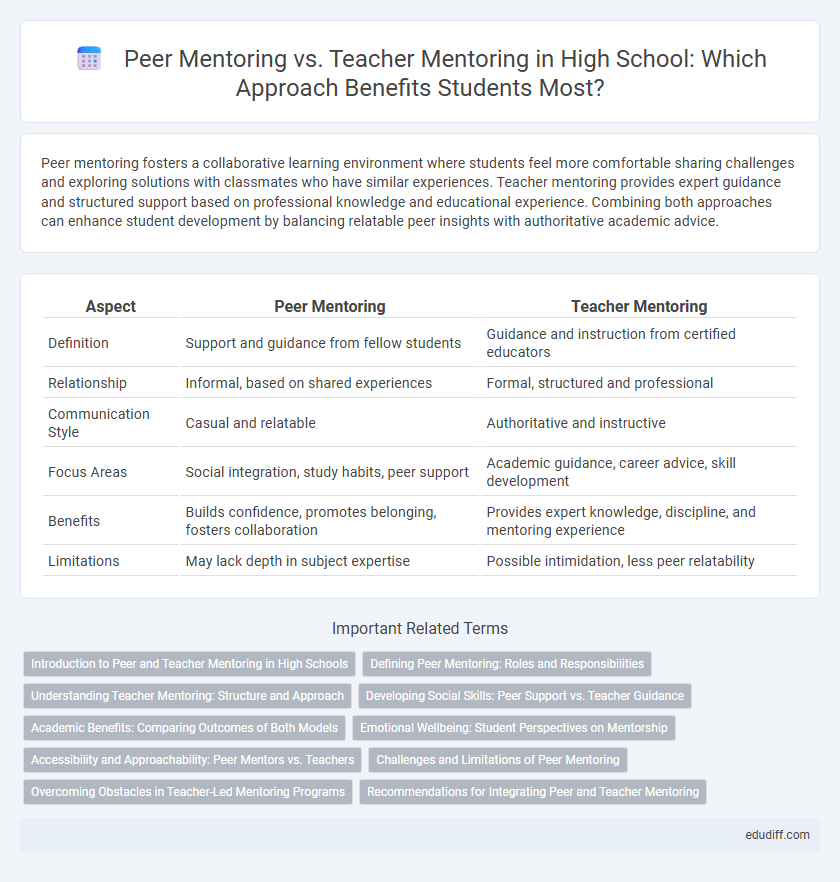Peer mentoring fosters a collaborative learning environment where students feel more comfortable sharing challenges and exploring solutions with classmates who have similar experiences. Teacher mentoring provides expert guidance and structured support based on professional knowledge and educational experience. Combining both approaches can enhance student development by balancing relatable peer insights with authoritative academic advice.
Table of Comparison
| Aspect | Peer Mentoring | Teacher Mentoring |
|---|---|---|
| Definition | Support and guidance from fellow students | Guidance and instruction from certified educators |
| Relationship | Informal, based on shared experiences | Formal, structured and professional |
| Communication Style | Casual and relatable | Authoritative and instructive |
| Focus Areas | Social integration, study habits, peer support | Academic guidance, career advice, skill development |
| Benefits | Builds confidence, promotes belonging, fosters collaboration | Provides expert knowledge, discipline, and mentoring experience |
| Limitations | May lack depth in subject expertise | Possible intimidation, less peer relatability |
Introduction to Peer and Teacher Mentoring in High Schools
Peer mentoring in high schools involves students providing guidance and support to their classmates, fostering a collaborative learning environment that enhances social skills and academic confidence. Teacher mentoring, on the other hand, is structured support from educators who offer expert advice, personalized feedback, and professional guidance to students. Both mentoring types contribute significantly to student development, improving engagement, motivation, and overall school success.
Defining Peer Mentoring: Roles and Responsibilities
Peer mentoring in high school involves experienced students providing guidance, support, and academic assistance to their peers, fostering a collaborative learning environment. Peer mentors develop leadership skills while helping mentees with study habits, time management, and social integration. This approach promotes mutual growth and enhances communication, empathy, and problem-solving abilities among students.
Understanding Teacher Mentoring: Structure and Approach
Teacher mentoring in high schools typically follows a structured framework where experienced educators guide new or struggling teachers through targeted feedback, goal setting, and professional development activities. This approach emphasizes formal training, curriculum alignment, and instructional strategies tailored to classroom management and academic standards. The mentor-teacher relationship is often scheduled and monitored by school administration to ensure consistent progress and accountability.
Developing Social Skills: Peer Support vs. Teacher Guidance
Peer mentoring in high school fosters social skills through relatable experiences and shared challenges, encouraging students to communicate effectively and build empathy within their peer group. Teacher mentoring provides structured guidance and models professional social behaviors, offering insights into conflict resolution and interpersonal dynamics. Combining peer support with teacher guidance creates a comprehensive environment that enhances students' social competence and emotional intelligence.
Academic Benefits: Comparing Outcomes of Both Models
Peer mentoring in high schools fosters academic engagement by promoting collaborative learning and relatable guidance, resulting in improved understanding of course material and higher student motivation. Teacher mentoring provides expert feedback, structured support, and personalized academic strategies, often leading to enhanced critical thinking skills and better performance on standardized assessments. Studies indicate that combining both models can maximize academic outcomes by leveraging peer encouragement alongside professional expertise.
Emotional Wellbeing: Student Perspectives on Mentorship
Peer mentoring fosters emotional wellbeing by offering relatable support and shared experiences that enhance student comfort and openness. Teacher mentoring provides structured guidance, drawing on professional expertise to address emotional challenges with proven strategies. Both mentorship types significantly contribute to a balanced emotional support system, catering to diverse student needs in high school environments.
Accessibility and Approachability: Peer Mentors vs. Teachers
Peer mentoring in high schools offers greater accessibility, as students often share similar schedules and social spaces, making it easier to connect informally. Peer mentors' relatability fosters approachability, encouraging open communication and reducing intimidation compared to traditional teacher mentoring. Teachers provide expert guidance but may be less available outside class hours, impacting their approachability for ongoing student support.
Challenges and Limitations of Peer Mentoring
Peer mentoring in high schools often faces challenges such as lack of training and experience among student mentors, which can hinder effective guidance and support. Limited authority may reduce peers' ability to enforce discipline or resolve conflicts compared to teacher mentoring. Additionally, peer mentors might struggle with maintaining boundaries, emotional maturity, and confidentiality, impacting the overall mentoring quality.
Overcoming Obstacles in Teacher-Led Mentoring Programs
Teacher-led mentoring programs in high schools effectively address obstacles such as limited student engagement and inconsistent guidance by providing structured support and expert knowledge. Overcoming challenges like communication gaps and varying student needs requires personalized approaches and continuous teacher training. Implementing regular feedback mechanisms ensures mentorship remains adaptive and student-centered, enhancing overall academic and emotional support.
Recommendations for Integrating Peer and Teacher Mentoring
Combining peer mentoring with teacher mentoring enhances high school students' academic success and social development by leveraging the unique strengths of both approaches. Schools should establish structured programs that facilitate collaboration between trained student mentors and certified teachers, ensuring comprehensive guidance and personalized support. Integrating regular communication channels and joint mentoring sessions fosters a cohesive learning environment that maximizes student engagement and growth.
Peer mentoring vs Teacher mentoring Infographic

 edudiff.com
edudiff.com